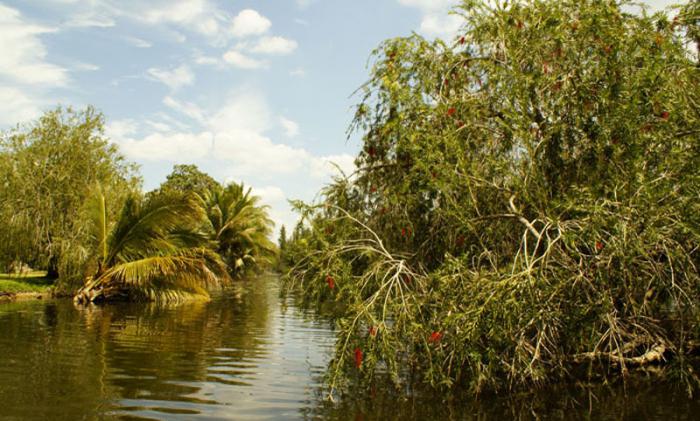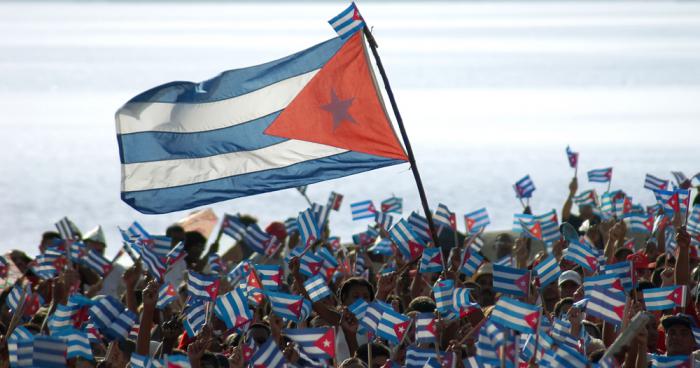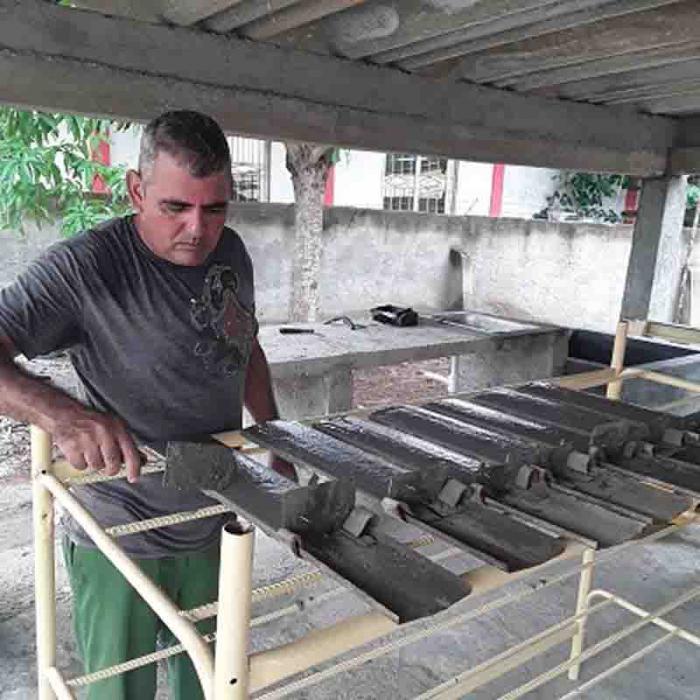Victoria de Girón Institute of Basic and Preclinical Sciences
A model for medical education
Author: Nuria Barbosa León |
internet@granma.cu
november 13, 2017 09:11:38

Photo: Ricardo López Hevia
“AND today the Revolution has strengths and resources and organization and people – people! Who are the most important element – to begin a plan to train as many doctors as necessary,” Comandante en Jefe Fidel Castro Ruz, on inaugurating the Victoria de Girón Institute of Basic and Preclinical Sciences, October 17, 1962.
Dermatologist Fernanda Pastrana Fundora has clear memories of that October 17 of 1962 and of the Comandante en Jefe during the inauguration of the Victoria de Girón Institute. She enrolled on that first course, after the revolutionary government called on citizens to study medicine given the lack of healthcare professionals to provide full coverage to the population.
Before January 1, 1959, there were 6,286 doctors in Cuba, however 3,000 emigrated from the country in the years following the Revolution, encouraged by the U.S. government in its attempts to destroy the new and just political system that was being constructed on the island.
Originally from the municipally of Cárdenas, Matanzas province, Fernanda received one of the scholarship programs created at the time, with accommodation provided in a mansion abandoned by the island’s bourgeoisie. As such she met and spoke with Fidel on many occasions during his frequent visits to the Institute.

Photo: Ricardo López Hevia
“One day they told the Comandante that I wasn’t doing well in my studies because I never went to gym class, which was an obligatory subject. He sat down with me and explained the importance of physical exercise for one’s health. When he finished, very embarrassed, I told him that I understood but didn’t like the subject. So he asked me to go to my gym teacher and tell them that the Revolution couldn’t afford the luxury of losing a doctor because they failed to attend physical education classes, and that I must convince the teacher to let me make up the classes as quickly as possible. And that’s just what I did, and I passed and was able to graduate.
“I think that Fidel helped twice, first by giving me the opportunity to study medicine, and then by giving me some necessary life advice. He taught me that in order to build a humanist social project, we must assume certain tasks even if not to our liking,” stated Fernanda.
Dr. Ernesto Bravo Matarazo, meanwhile, was one of the first teachers on the program. He explained that “biochemistry was always a very difficult subject and the students didn’t like it. In truth you needed to have some prior knowledge of chemistry to understand it.
“During one of his visits, students asked Fidel to speak to the professors and ask them to be more flexible. Fidel asked when the date of the exam was and began to study with the students in the days leading up to it. We teachers thought he was going to tell us to go easier on the students, but all he said was ‘How beautiful is biochemistry!’ He praised the subject saying that it was important for society. His words motivated the students and they began to apply themselves to their studies and the exams never got any easier.”

Photo: Ricardo López Hevia
The professor, originally from Argentina, noted that the Victoria de Girón Institute emerged at a very convulsive time for the Revolution, following the defeat in April,1961, of mercenaries sent by the United States at Playa Girón, after the completion of the national literacy campaign, and during the October Crisis.
Also a consultant professor, Matarazo noted: “We implemented many of the objectives outlined in the University Reform program approved in the Argentine city of Córdoba in 1918 regarding setting up scientific groups and student aides so that the students could become involved in research and teaching. Our main task has been to develop study habits based on an updated bibliography in order to respond to the academic demands and increase students’ knowledge.”
The doctor described Victoria de Girón as a laboratory to test out the teaching programs to be implemented around the country and praised the highly-qualified teaching staff, many of whom hold Masters or PhDs, who have supported the work of the institution over the last 60 years.
Today, he knows directors of prestigious medical universities from around the world who are surprised to learn that Cuba has a faculty dedicated to basic and preclinical sciences, given the international focus on theoretical training from first through fifth year, with little opportunity to practice with patients.
INTERNATIONAL STUDENTS
In the early years of the Institute, Bravo Matarazo recalls the arrival of students from Vietnam, which was at war with the United States at the time; as well as the departure of the first group of internationalist doctors who went to serve in Algeria. “Today we teach hundreds of international students at the institution and faculties based in other countries,” he stated.
Meanwhile, MHSc. María Elena Fernández Roque, director of the International Relations Department of Havana’s University of Medical Sciences, noted that this educational institution currently has over 6,000 students from other nations studying degrees in medicine, dentistry, nursing and health technology, as well as mid-level courses in these specialties. The university is currently working on nine projects with seven countries, and has 22 agreements with 22 universities in 14 countries.
According to the healthcare professional, students are either self-financed, government-sponsored, or receive one of the full scholarship programs Cuba offers.
“They all receive the same study plan, have the same tasks and rights as Cuban students and even wear the same uniform,” stated Fernández Roque, who is also an assistant professor.
“The students feel very at home with us,” she explained, before recalling the words of Fidel when he stated that Victoria de Girón would train doctors for Cuba and the world.
“We have students from dozens of different nations in our classrooms; which helps with integration, and who offer help and support to one another. We say that the A - for Angola - to Z - for Zimbabwe - of nations is represented with us,” she added.
Fernández Roque went on to note that international students receive specialized and conscientious care, but never receive preferential treatment over the Cubans. They are tended to by support professors, who help them to adapt to the way of life on the island. The non-Spanish speaking students take a preparatory course to learn Spanish and standardize their knowledge so that they can assimilate the university-level content.
“These students participate in approved research projects in our country, attend scientific events, can choose to become student aides, and even participate in sporting competitions and in amateur arts festivals at the university. They can also volunteer to join the Federation of University Students and take on positions and responsibilities within the organization, she added.
Dr. Nidia Márquez Morales, deputy rector of the University of Medical Sciences, shares a similar opinion, noting that international students continue to practice their customs and traditional cultures. “Several are affiliated with the African Union and organize inter-cultural encounters where they wear traditional dress, make traditional food, and present their national art forms. Everyone comes together, even the Cubans.”
MEDICAL SCIENCES IN CUBA
According to Fernández Roque, the Victoria de Girón Institute is the leading faculty in the country for medical sciences education, as it is the top institute for methodological work and management of the different subjects within the Cuban academic model.
The faculty is one of the thirteen that make up Havana’s University of Medical Sciences which features a roster of almost 17,000 students, with some 21,000 studying technical courses. Students can either enroll after completing middle school, or 12th grade, which is why a polytechnic institute dedicated to healthcare exists.
The establishment also offers a wide range of postgraduate courses, 37 Masters degree programs and trains 4,000 residents across 62 specialties.
“This university is undergoing a quality assessment process, undertaken and directed by the Ministry of Higher Education through its regulatory body, the National Accreditation Board,” explained the deputy rector.
“All our university’s medical degrees are accredited, 50% of which are rated excellent; as well as 17 Masters programs, 11 of which are also rated excellent,” she added.
Meanwhile, the capital’s 54 hospitals function as the main teaching spaces of the University, while its staff roster features 7,443 healthcare professionals, 80% of whom are doctors, nurses, or technicians who work at these institutions.
From 2015 to 2017, the University underwent repair and refurbishment works. The 13 faculties currently have basic sciences laboratories, some with multi-purpose classrooms featuring microscopes, and new study resources.
“We insist,” the director noted “upon the use of uniform and adequate physical appearance when offering medical services. We place a lot of emphasis on the ethical behavior of our students because starting from first year they work with patients in doctors’ surgeries, polyclinics and hospitals. They interact with relatives and society in order to acquire the skills and understanding they need to do their job well.”
An example of such is clinical biochemistry resident, Javier González Argote, who graduated top of his class in teaching, research and history in 2017, and has received various awards for his scientific work and research into neuroscience, principally disorders caused by diabetes in pregnant women.
Undertaking similar investigations is fifth year medical student Alexis Alejandro García Rivero, who works as a student aid to help teach Physiology. “Being a medical sciences student and specifically from the Victoria de Girón faculty is a privilege. I’m very proud to be studying on this university campus,” he stated.
http://en.granma.cu/cuba/2017-11-13/vic ... l-sciences
So, I am given to understand that this is what a betrayed revolution looks like...












